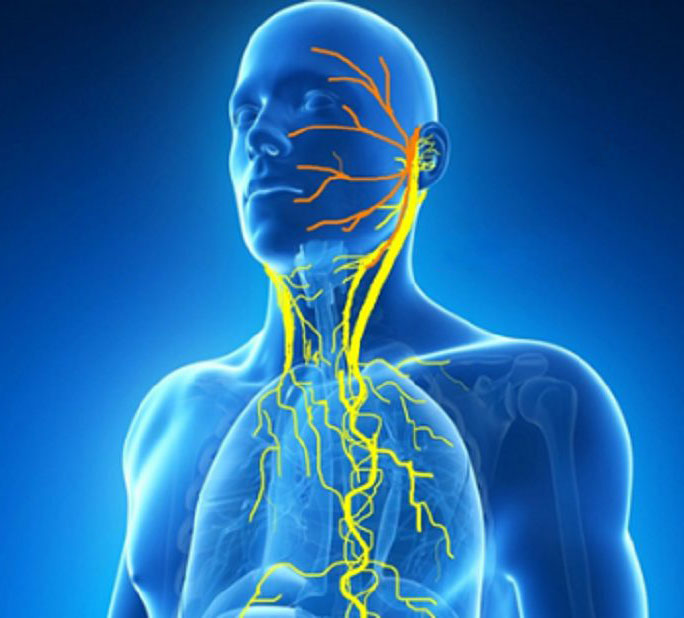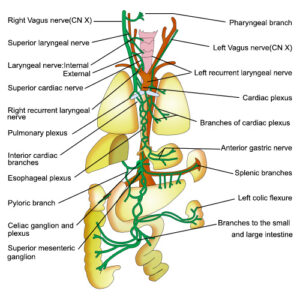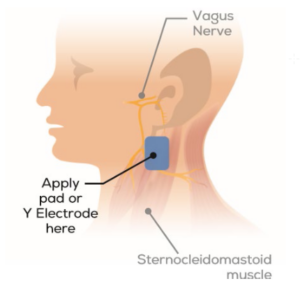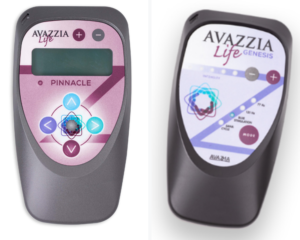
This blog is a much-requested topic over in the Pain Free For Life Community, and this week, I’m delivering! You may remember a couple of weeks ago; I published an article about Polyvagal Theory and how it can help promote healing. While writing that blog, I got to thinking…” It’s about time I share the details of my doctorate dissertation; Non-invasive Vagus Nerve Stimulation for Elimination of Inflammation Using Microcurrent.”
This topic is very close to my heart. In fact, Vagus Nerve Stimulation is one of the key protocols that helped me heal from the debilitating pain and anxiety of scoliosis as a child. Kick back, relax and get ready to learn more about the Vagus nerve!
Meet the Vagus Nerve:

You may have heard of Kevin Tracey’s ground-breaking research that explored the connection between the brain and pain. His findings showed us that our bodies aren’t merely at the mercy of physical hurt but are instead connected to an invisible interplay with our brains!
Tracey theorized this interplay was most likely due to something called “the Vagus nerve.” This cranial nerve interacts with your parasympathetic nervous system (rest/digest) and visceral organs, intensifying and stopping inflammation when necessary.
Inflammation & Pain: What’s the Connection?
Do you experience regular pain without understanding the cause? It’s probably related to inflammation. Inflammation is an often beneficial natural defense mechanism that protects your body from infection and foreign invaders like bacteria and viruses.
Symptoms such as redness, heat, swelling, pain, and loss of function can be typical signs of inflammation in your body. The problem with inflammation occurs when it persists longer than the original issue, turning chronic.
What Are Chronic Inflammatory Conditions?
Chronic inflammatory diseases can majorly impact your health and quality of life. Examples of chronic inflammatory diseases include:
- Rheumatoid arthritis
- Lupus
- Psoriasis
- Crohn’s disease
- Multiple sclerosis
- CRPS
- And inflammatory bowel disease (or IBS)
While there are many other chronic inflammatory conditions, they all share the common feature of pain, each with a set of distinct symptoms.
The Unifying Law of Pain
When writing my dissertation, I always kept the Unifying Law of Pain at the top of my mind. Proposed in 2007 by Sota Omoigui, MD, this law claims that inflammation is the root cause of all pain disorders we experience today! Understanding that these syndromes are mere variations or expressions of an inflammatory response enables us to recognize a unifying thread between them: they originate from within.
I hope that by understanding this connection and exploring how it manifests differently in different people, we will one day be able to solve the problem of unnecessary pain.
What Is Non-Invasive Vagus Nerve Stimulation?

At the heart of my research lies Non-Invasive Vagus Nerve Stimulation – THE #1 way of overcoming difficult-to-treat pain, chronic stress, and inflammation. Our Avazzia Life Microcurrent Devices enable you to perform microcurrent Vagus nerve stimulation at home whenever you’d like. As such, that’s precisely what I used when conducting my 20 Case Studies for this research.
Invasive Vs. Non-Invasive Vagus Nerve Stimulation: What’s the Difference
You have two options if you’d like to benefit from Vagus nerve stimulation. Invasive and non-invasive methods. Microcurrent therapy stands out as the preferred non-invasive choice for many people looking to avoid surgery or implantation. With its ability to directly target your Vagus nerve with gentle low-level electrical energy, it’s generally considered safer than more intrusive techniques like implantation.
What Are The Benefits Of Using Microcurrent Therapy?

Microcurrent therapy has many potential benefits aside from its ability to decrease inflammation and eliminate pain. These include improved sleep quality, increased energy levels, improved mental clarity, reduced stress, and enhanced overall well-being.
Additionally, microcurrent has been shown to promote wound healing, stimulate nerve repair and regeneration, which can help you recover more quickly from injuries or illnesses such as stroke or spinal cord injury. Finally, studies have found that microcurrent stimulation can also increase collagen production, which helps improve skin texture and tone while reducing wrinkles.
Case Studies
For this study, I recruited 50 people with varying degrees of chronic pain to use as case studies. The participants were carefully selected from a large pool and represented different ages, ethnicities, genders, and locations – the youngest being 24 and the oldest 79!
Some had previously tried allopathic medical procedures for relief, while others believed in alternative remedies; 17 even expressed their skepticism about whether my findings would offer them any reprieve. What united them was their longing for an end to the pain that tied each one together.
Research Protocol
At the start of each session, I analyzed the subject’s pain location and diagnoses. During this time, I asked for an entire case history to understand what other therapies had been tried in the past and whether they were successful. As part of this process, we also collected reference points from a modified pain chart to track the subject’s pain level that day. Once all this was established, I explained and demonstrated how to do the therapy via Zoom or Skype before sending them a video for reference purposes. Finally, we got them to run through the procedure on camera with me so that I could confirm their understanding and answer any questions they may have had.
The Protocol Participants Used:
Vagus Nerve Stimulation—10-Minute Training
- The Vagus nerve was accessed by locating the carotid artery on the left side of the neck.
- An electrode was then placed just behind this artery as it runs piggyback to it.
- The Avazzia Life Evolution device was switched on, connected with a Y Electrode, and placed vertically on the left side of the neck at 7-12 Hz frequency.
- Power level should be adjusted until a gentle tingle is felt for therapy to be successful; muscles jiggling indicate that location is correct (about 1 inch below ear lobe).
- Stimulation was to last 3 minutes minimum, repeated four times per day.
The Results
Using the protocol above, I conducted 20 case studies that yielded exciting results. To go over each one would take all day, so here are two top highlights for you to review:
Note: To protect privacy, all participants will go by Subject Numbers.
Subject 4 is a prime example of how taking proactive measures to manage chronic Crohn’s Disease can decrease pain. Subject 4 is a 33-year-old African American male from the United States with a diagnosis of Crohn’s Disease for the last five years. After initially attributing his symptoms to stress, further examination revealed the severity of his condition. In just four weeks of therapy, Subject 4 saw his pain decrease from a 6/10 to a 3/10. That’s impressive progress toward living life with fewer restrictions!
Another stand-out from the study was Subject 10, A 54-year-old Hispanic female from the United States, suffering from Fibromyalgia for the past nine years. Her symptoms included relentless pain, fatigue, anxiety, and depression. After several weeks she was able to reduce her pain from a (6-7/10) down to a 3/10. When I met with her at the end of the final week, she reported that her pain had been reduced to a 1/10, and her anxiety had also decreased dramatically.
It was remarkable to watch my patients transform in such a short period. Amazing things can happen when we are proactive about our health.
Research Summary
The findings from my research suggest that Non-Invasive Vagus Nerve Stimulation using microcurrent therapy could be an effective alternative treatment for those suffering from chronic inflammation or other conditions related to chronic pain.
By stimulating the Vagus nerve through low-level electrical energy, we can reduce inflammation without any adverse side effects or discomfort. As more research is conducted on this subject, we will continue to learn more about its potential benefits for treating various physical and mental conditions.
If you’re looking for an alternative way to manage your chronic pain or inflammation, I encourage you to consider giving Non-Invasive Vagus Nerve Stimulation using microcurrent therapy a try!
There is no one size fits all solution when treating chronic pain; however, there are alternatives out there that could provide significant relief without resorting to drugs or surgery. If you need help getting started with microcurrent therapy or picking the right microcurrent device for you, we’re here to help. Reach out to [email protected].





